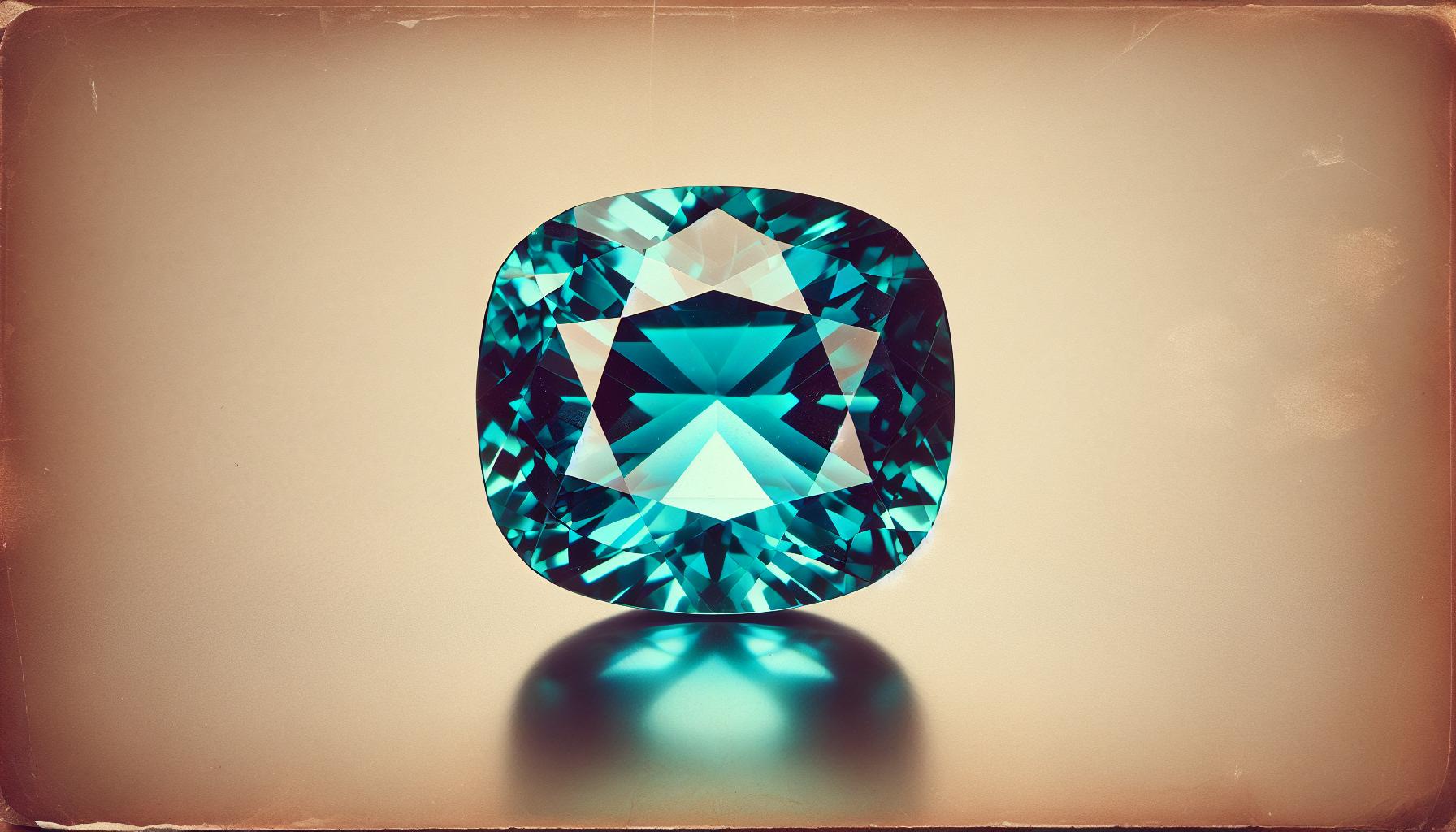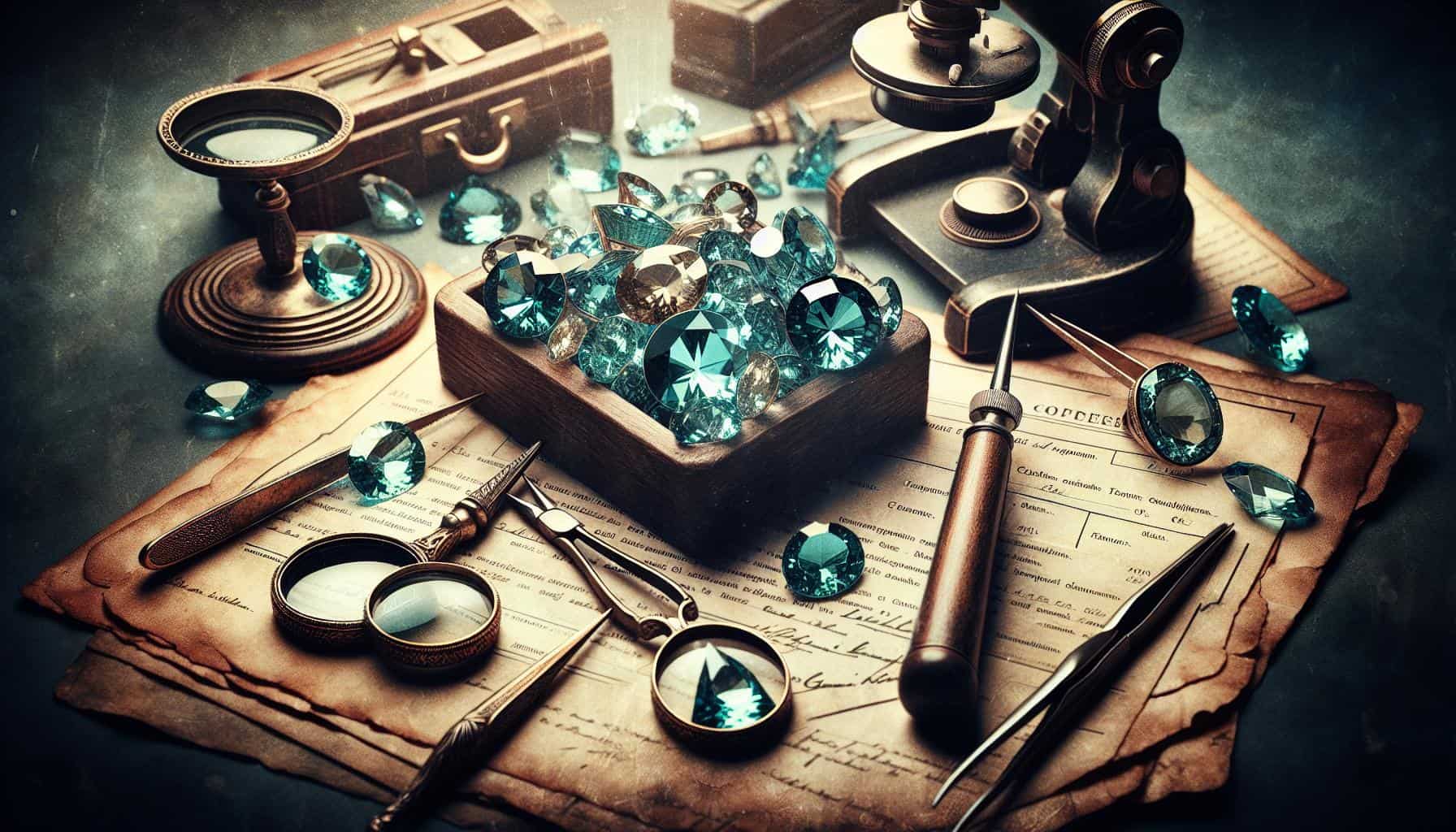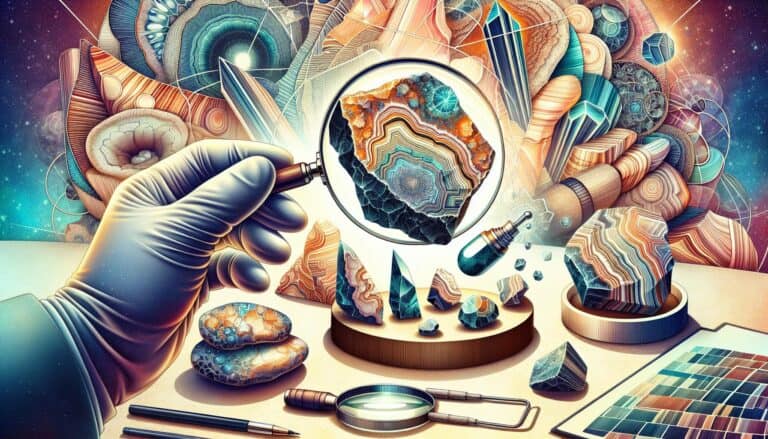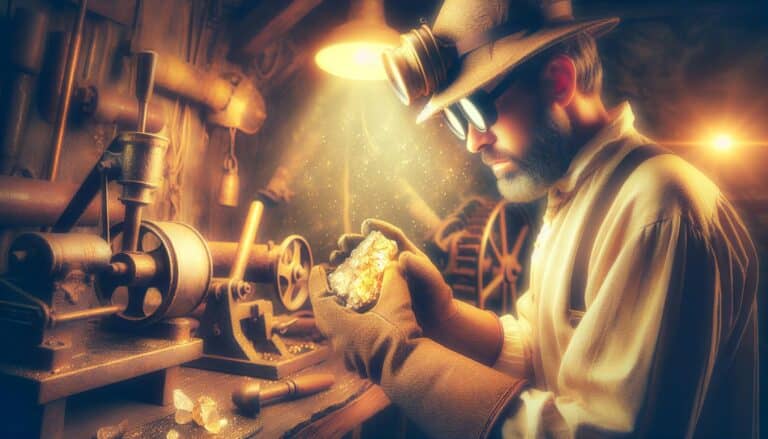Curious about the value of apatite, the gemstone that’s catching everyone’s eye?
You’re not alone. Apatite’s worth can vary widely, and you’re about to discover why. Known for its striking colors and versatility, apatite is a gemstone enthusiast’s delight, but pricing can be as complex as the stone itself.
Factors like color, clarity, size, and treatment all play pivotal roles in determining apatite’s value. Whether you’re a collector, a jewelry lover, or considering an investment, understanding these nuances is key.
Let’s dive into the world of apatite and unravel the mystery behind its worth.
Apatite’s worth hinges on color, clarity, cut, and carat weight. Highly valued for its neon blue-green hues, particularly from Madagascar, its rarity and quality greatly influence its price. Authenticity, ensured through certification, affects value. Purchase from reputable sources to guarantee quality in this unique, vibrant gemstone.
What Is Apatite?
You may have heard of apatite as it inches its way into the spotlight of gemstone aficionados and jewelry markets worldwide. But what exactly is this captivating gem?
Apatite is a group of phosphate minerals, widely known for its rich array of colors from deep blues and greens to yellows and pinks. This gemstone is quintessential for collectors who prize unique gems with impressive color saturation and natural beauty. Unlike more widely recognized stones such as diamonds or rubies, apatite is relatively unknown to the general public, giving it an allure of exclusivity.
While it ranks a 5 on the Mohs scale of hardness, apatite isn’t as durable as some of the classic gemstones. This means you’ll need to exercise a bit of caution with apatite jewelry, taking extra care to avoid scratches and direct impacts that can damage the stone.
- Colors: Deep blues, greens, yellows, pinks
- Mohs hardness: 5
- Chemical composition: Calcium phosphate
One of the most desirable varieties of apatite is the neon blue-green variant commonly sourced from Madagascar. Its striking hue can rival the tropical ocean in vibrance and clarity, making it a prized specimen in any collection. But apatite’s color isn’t its only notable feature. It’s also known for its use in various industrial applications, from fertilizers due to its phosphate composition to potential uses in the field of waste treatment.
When you’re weighing the worth of apatite, it’s crucial to remember that its value goes beyond aesthetics. The gem’s demand in industrial sectors can influence its market value. However, it’s the gemstone’s rich color and clarity that predominantly dictate its desirability among gem enthusiasts.
As you delve deeper into the world of gemstones, keep an eye out for apatite’s emerging market presence. Showcasing a blend of beauty and utility, apatite may well find its place amongst your treasured possessions.
Apatite Prices: Factors That Affect Value

When you’re looking to invest in apatite, it’s crucial to understand what influences its market value. Several factors play a significant role in determining the worth of this colorful gemstone. From the specific hues to the precision of the cut, each attribute has the potential to either elevate or diminish the stone’s overall value.
Color, Clarity, and Cut Quality
The color of apatite can vary widely, with certain shades being more sought after than others. The neon blue-green variety from Madagascar is among the most prized for its vivid saturation and unique appeal. Colors that show a deep and intense hue are typically more valuable than those with lighter or more subdued tones.
Clarity is another important factor that impacts apatite’s value. Stones with fewer inclusions are considered more desirable as they allow more light to pass through, enhancing the gemstone’s natural brilliance. However, finding an apatite with perfect clarity is rare, and some buyers might appreciate the uniqueness of a stone with visible inclusions.
The cut quality also plays a fundamental role. A well-executed cut can bring out the best in a gemstone, maximizing its luster and appeal. Apatite isn’t as hard as some other gemstones, so an expert cut is vital to endure the wear and tear of daily use without compromising the stone’s beauty. The more precise and intricate the cut, the higher the labor costs, which can add to the final price tag of the gemstone.
Market Demand and Availability
Apatite’s rarity contributes directly to its exotic allure and price. The market demand for high-quality apatite has grown significantly, but the supply, particularly for top-tier colors, can be quite limited. Rising demand coupled with limited availability drives up prices, especially for stones with exceptional characteristics.
Industry usage also influences apatite’s market value. Its utility beyond jewelry, such as in the production of fertilizer due to its phosphate content, can affect its availability for gemstone purposes. The more industries compete for apatite, the higher the potential cost for the gem-quality stones.
Market trends and consumer preferences change over time, and these changes can have a substantial impact on apatite’s value. Should a prominent figure endorse apatite or if it becomes a fashion trend, you might see an upward spike in its value. Conversely, if it falls out of favor, prices could decrease.
Prices for apatite are nuanced and dependent on a combination of its physical attributes and the whims of market demand. You should pay close attention to market trends and the quality factors discussed when considering apatite as a financial investment.
Understanding Apatite: A Rare Gem

When you’re considering the worth of apatite, it’s essential to delve into what makes this gemstone stand out. Apatite’s rarity and unique properties contribute significantly to its value, making it a fascinating subject for collectors and gem enthusiasts alike.
The Rarity of Apatite
Apatite’s value is greatly influenced by its rarity. Unlike more common gemstones like amethyst or quartz, apatite is not found abundantly, which can turn your quest for a high-quality piece into quite the treasure hunt. Neon apatite and stones with exceptional clarity are especially rare, adding to their allure and value. Here are some factors that contribute to its scarcity:
- Limited Deposits: Apatite is found in specific geological settings, often in smaller, less accessible locations compared to more widely mined minerals.
- Market Availability: High-quality apatite is not always available on the open market, as smaller quantities are mined and distributed, which limits its supply and boosts its exclusivity.
The scarcity of apatite, especially in its more extraordinary forms, has a direct impact on its market price.
Origins and Characteristics
Apatite’s origins are as varied and fascinating as the mineral itself. Deposits can be found worldwide, from the depths of Russia to the shores of Brazil and Madagascar. The gemstone’s aesthetics can vary depending on its source, influencing its desirability and price.
Characteristics such as color, clarity, and cut quality are instrumental in determining an apatite’s worth. The stone’s color range includes blues, greens, yellows, and even violets, but the most sought-after are vibrant blues or greens with a neon quality. In terms of clarity, apatite that is free from visible inclusions or imperfections commands a higher price. As for the cut, a well-executed facet can enhance the stone’s brilliance, making it more attractive to buyers and collectors.
Factors such as its geological formation and the skill required to extract and craft the gem contribute to its ultimate value. Each characteristic of apatite speaks to its journey from creation to the final polished stone you might hold in your hand.
Apatite Grading and Valuation
The Grading System for Apatite
Just like diamonds and other precious gemstones, apatite’s value is significantly influenced by its quality, which is determined through a grading system. When gemologists grade apatite, they look specifically at the Four Cs: color, clarity, cut, and carat weight.
- Color: Apatite comes in an expansive spectrum of colors, but the most coveted is the intense neon blue-green found in Madagascar. The saturation and hue of the color can greatly affect the stone’s value.
- Clarity: Apatite is somewhat infamous for its inclusions, which means that finding a piece with high clarity is rare and thus, more valuable.
- Cut: The gemstone’s brilliance and visual appeal are largely determined by its cut. A skilled cut can enhance the stone’s best features, making it more desirable.
- Carat Weight: Larger pieces of apatite are uncommon; therefore, the price per carat tends to increase with size.
Understanding these parameters is crucial for anyone looking to buy or invest in apatite. Additionally, the market also considers the origin of the apatite, with stones from certain locations being more prized than others.
Certification and Appraisal
When you’re purchasing a gemstone like apatite, having it certified by a reputable gemological lab can provide assurance about its authenticity and quality. A certificate typically includes a detailed analysis of the gemstone’s physical and optical properties aligned with the grading system. This serves as a backbone for its valuation.
Appraisal goes a step further – it’s the process by which the monetary worth of your apatite is estimated. Professional appraisers employ their expertise to evaluate the stone based on current market trends, the Four Cs, and additional factors such as the gemstone’s historical significance or provenance.
- Transparency in the Market: A certification and appraisal process adds a layer of trust and transparency in the gemstone market – keys to buyer confidence.
- Insurance and Resale: These documents are also important for insurance purposes or if you intend to resell the stone in the future.
Remember, certification and appraisal can come with additional costs, but they’re investments in the security of your purchase and peace of mind. Whether it’s for personal adornment or potential financial gain, understanding the intricacies of apatite’s grading and valuation will navigate you toward making an informed acquisition.
Current Market Trends in Apatite Pricing
As you delve into the world of apatite, you’ll find that current market trends play a pivotal role in determining its value. The demand for apatite has surged due to its versatility and the spectrum of colors it offers, from neon blues to deep purples.
Historically, the gemstone’s pricing has been relatively affordable compared to more mainstream precious stones, yet certain colors like the Paraíba-like blue-green apatite can fetch higher prices, reflecting trends often seen in the tourmaline market. Apatite’s popularity in metaphysical circles further drives its demand, with many attributing healing and inspirational properties to the stone.
Here’s a quick look at some factors influencing apatite prices in recent times:
- Innovative Jewelry Designs: Artisans and jewelers are increasingly incorporating apatite into unique pieces, elevating its status and thus, its market value.
- Geopolitical Factors: The majority of apatite is mined in countries like Madagascar and Brazil, where political stability and mining regulations can impact supply and prices.
- Technological Advancements: Improved cutting and polishing techniques have enhanced the beauty of apatite, making it more desirable to consumers and thereby affecting price points.
The following table offers a snapshot of apatite’s price range based on quality and size:
| Quality | Carat Range | Price Range (USD) |
|---|---|---|
| Low | 1 – 5 | $5 – $50 |
| Medium | 1 – 5 | $50 – $200 |
| High | 1 – 5 | $200 – $500 |
It’s essential to regularly monitor these shifting market dynamics if you’re considering investing in apatite or simply wish to add a unique gem to your collection. Keep an eye on gemstone trade shows and auction results for the latest insights on how apatite’s value is assessed within the gem community. Remember, factors like innovative uses and consumer tastes can quickly change, influencing the pricing landscape of this gemstone nichemarket.
The Most Expensive Apatite
Understanding what sets the price bar high for apatite stones is essential to grasp the top tier of the market. The Most Expensive Apatite is typically characterized by a deep, vivid blue or green color, akin to the hues of tropical oceans. It’s the rarest and most sought-after, ensuring that prices reflect its scarcity and desirability.
Factors that catapult apatite into the higher price echelons include:
- Exceptional Clarity: The more transparent and blemish-free, the higher the value.
- Optimal Cutting: Expert faceting enhances brilliance and fetches premium prices.
- Significant Carat Weight: Larger stones are rarer, driving up their worth.
- Provenance: Stones with a documented history of origin often command higher prices.
Prices skyrocket when apatite showcases the optimal combination of all the Four Cs. Some top-grade blue apatite can fetch prices of well over $100 per carat, particularly when exceeding 5 carats and showing near-perfect clarity. In contrast, smaller, less vibrant stones may only be a fraction of that.
Let’s consider a recent real-world example. At a prestigious auction, an exceptionally clear, 10-carat blue apatite specimen encased in a designer setting sold for over $5,000. This sale underscored the potential investment value of high-quality apatite in the luxury market.
To give you an idea of the possible price ranges for premium apatite, refer to the following table:
| Carat Weight | Expected Price Range |
|---|---|
| 1 – 5 | $100 – $500 per carat |
| 5 – 10 | $500 – $1,000 per carat |
| 10+ | Upwards of $1,000 per carat |
Bear in mind that these figures are approximate and can be influenced by current market sentiments, designer reputation, and individual stone qualities. It’s wise to stay informed on pricing trends and to consult with a reputable gemologist or jeweler for accurate appraisals. Demand for apatite remains strong amongst collectors and connoisseurs, who recognize the stone’s unique beauty and potential for appreciation.
Buying Apatite: Tips and Recommendations
When looking to acquire apatite, it’s essential to know where to shop and how to ascertain its authenticity and inherent value. You’ll want to gain the most from your investment, whether for personal enjoyment or resale purposes.
Where to Purchase High-Quality Apatite
Finding reputed vendors is crucial when you’re in the market for high-quality apatite. Here are some recommended sources:
- Specialized Gemstone Dealers: Experts in gemstones can provide a wide selection of apatite with the assurance of quality.
- Jewelry Stores: Renowned jewelers often have a collection of gemstones, including apatite, set in various types of jewelry.
- Online Marketplaces: Platforms such as Etsy or eBay can offer numerous options, but ensure you’re dealing with a trusted seller.
- Gem and Mineral Shows: Such events allow you to explore a range of apatite stones and negotiate prices.
Before making a purchase, you should:
- Research the dealer’s reputation.
- Ask for a high-resolution image or video if buying online.
- Verify the source’s return policy in case the apatite doesn’t meet your expectations.
Ensuring Authenticity and Value
To ensure you’re getting genuine apatite and the best value for your money, consider the following:
- Request a Certificate of Authenticity: This document proves the stone’s origin and quality.
- Check for Grading Reports: Reputable labs like GIA provide grading based on the Four Cs.
- Understand Treatment Disclosures: Some apatite may be treated to enhance color or clarity; this should be disclosed by the seller.
- Seek Professional Appraisals: A certified gemologist can provide an accurate assessment of the stone’s value.
- Keep abreast of Market Trends: Prices can fluctuate, so stay informed on the current market situation.
Paying attention to these details will help safeguard your investment and ensure you’re delighted with your apatite purchase. Always bear in mind that the true worth of the stone lies in its appeal to you as much as its monetary value.
Conclusion: Buying & Selling Apatite
So you’re now equipped with the knowledge to navigate the apatite market.
Remember that its worth is more than just a price tag—it’s about the quality, certification, and the confidence you gain in your purchase. By insisting on certified apatite and seeking professional appraisals, you’re not just buying a gemstone; you’re investing in a piece of the earth’s beauty that holds its value. Keep your eyes on market trends and don’t hesitate to ask for the documentation that proves the stone’s pedigree.
With these strategies, you’ll enjoy the full spectrum of apatite’s value, both aesthetically and financially.
Happy gem hunting!







